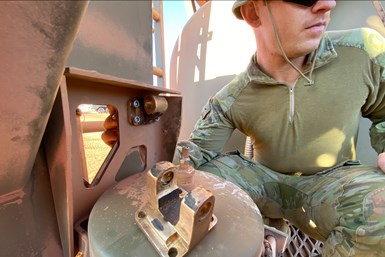Australian Army Field Trials Prove Metal 3D Printing Capabilities
Soldiers overcame extreme field conditions to design, print and finish a series of groundbreaking 3D-printed parts using ‘WarpSPEE3D’ metal 3D printer.
Share
Read Next

Field trial included printing an essential metal mounting bracket for a bulk fuel support module which was not in the field supply inventory.
Australia‘s Army completed a successful two-week field trial of a ‘WarpSPEE3D’ metal 3D printer at the Mount Bundey Training Area, Northern Territory. A team of Royal Australian Electrical and Mechanical Engineers (RAEME) soldiers from the 1st Combat Service Support Battalion (1CSSB) tested the printer in extreme conditions to design, print and finish a series of 3D-printed parts in the field as case studies.
The trial proved that metal 3D printing (enabled by appropriate technical documentation and engineering processes) can support the Army’s supply chain resilience and strengthen Australia’s sovereign capability. Developed by SPEE3D, an Australia manufacturer of metal additive manufacturing (AM) technology, WarpSPEE3D is the world’s first large-format metal 3D printer to use cold spray technology.
The company says the printer is capable of printing large metal parts up to 40 kg at a speed of 100 g per minute. The process harnesses the power of kinetic energy, rather than relying on high-powered lasers and expensive gasses, allowing 3D metal printing in the field at an affordable cost.
Prior to the trial, the team conducted 3D printing training at Charles Darwin University, learning the skills they would need to design, print, heat treat, machine, test and install replacement metal parts that can be difficult to replace with existing supply chains.
In one of the case studies during the trial, the team printed a gunner’s ratchet. This specialized multitool is used by in the service of the M242 Australian Light Armoured Vehicle Machine Gun. Sourcing the tool using existing supply chains can cost the Australian Army significant time and money. During the trial it was proven that the ratchet can be easily replaced on demand and in the field with a version designed by 1CSSB personnel. The 1CSSB design was 3D printed in under an hour and with a material that costs approximately $100.
The trial also included the design and printing of an essential metal mounting bracket that is used on a bulk fuel support module which was not in the field supply inventory. The part only took 30 minutes to print, proving that with some design skills and metal 3D printing, Army soldiers can solve common problems. These case studies, along with over 40 others developed during the program, now form a digital library that can be accessed and printed on demand. Soldiers in the field can utilize the 3D metal printing in order to supplement existing supply chains and get equipment back into action quickly.
Related Content
-
This Year I Have Seen a Lot of AM for the Military — What Is Going On?
Audience members have similar questions. What is the Department of Defense’s interest in making hardware via 3D printing over conventional methods? Here are three manufacturing concerns that are particular to the military.
-
For Coast Guard, AM Adoption Begins With “MacGyver-ish” Crew Members Who Are Using 3D Printing Already
AM suits the Coast Guard’s culture of shipboard problem-solving, says Surface Fleet AM lead. Here is how 3D printers on ships promise to deliver not just substantial cost savings but also an aid to crew capabilities and morale.
-
Big Metal Additive: The Difference Between a Shape and a Part Is Quality
Preparing to scale directed energy deposition to ongoing full production is not a technological challenge: DED is ready. But it is an organizational challenge, says the company founder. Here is what it means to implement a quality system.













